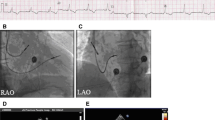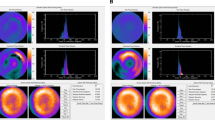Abstract
Purpose
The purpose of this study was to evaluate left ventricular (LV) mechanical dyssynchrony in patients with Wolff-Parkinson-White (WPW) syndrome pre- and post-radiofrequency catheter ablation (RFA) using phase analysis of gated single photon emission computed tomography (SPECT) myocardial perfusion imaging (MPI).
Methods
Forty-five WPW patients were enrolled and had gated SPECT MPI pre- and 2–3 days post-RFA. Electrophysiological study (EPS) was used to locate accessory pathways (APs) and categorize the patients according to the AP locations (septal, left and right free wall). Electrocardiography (ECG) was performed pre- and post-RFA to confirm successful elimination of the APs. Phase analysis of gated SPECT MPI was used to assess LV dyssynchrony pre- and post-RFA.
Results
Among the 45 patients, 3 had gating errors, and thus 42 had SPECT phase analysis. Twenty-two patients (52.4 %) had baseline LV dyssynchrony. Baseline LV dyssynchrony was more prominent in the patients with septal APs than in the patients with left or right APs (p < 0.05). RFA improved LV synchrony in the entire cohort and in the patients with septal APs (p < 0.01).
Conclusion
Phase analysis of gated SPECT MPI demonstrated that LV mechanical dyssynchrony can be present in patients with WPW syndrome. Septal APs result in the greatest degree of LV mechanical dyssynchrony and afford the most benefit after RFA. This study supports further investigation in the relationship between electrical and mechanical activation using EPS and phase analysis of gated SPECT MPI.

Similar content being viewed by others
References
Klein GJ, Yee R, Sharma AD. Longitudinal electrophysiologic assessment of asymptomatic patient with the Wolff-Parkinson-White electrocardiographic pattern. N Engl J Med 1989;320:1229–33.
Blomström-Lundqvist C, Scheinman MM, Aliot EM, Alpert JS, Calkins H, Camm AJ, et al. ACC/AHA/ESC guidelines for the management of patients with supraventricular arrhythmias—executive summary: a report of the American College of Cardiology/American Heart Association Task Force on Practice Guidelines and the European Society of Cardiology Committee for Practice Guidelines (Writing Committee to Develop Guidelines for the Management of Patients With Supraventricular Arrhythmias). Circulation 2003;108:1871–909.
Tomaske M, Janousek J, Rázek V, Gebauer RA, Tomek V, Hindricks G, et al. Adverse effects of Wolff-Parkinson-White syndrome with right septal or posteroseptal accessory pathways on cardiac function. Europace 2008;10:181–9.
Kwon BS, Bae EJ, Kim GB, Noh CI, Choi JY, Yun YS. Septal dyskinesia and global left ventricular dysfunction in pediatric Wolff-Parkinson-White syndrome with septal accessory pathway. J Cardiovasc Electrophysiol 2010;21:290–5.
Nakajima K, Bunko H, Tada A, Taki J, Tonami N, Hisada K, et al. Phase analysis in the Wolff-Parkinson-White syndrome with surgically proven accessory conduction pathways: concise communication. J Nucl Med 1984;25:7–13.
Dormehl IC, Bitter F, Henze E, Adam WE, Weismüller P. An evaluation of the diagnostic efficacy of phase analysis of data from radionuclide ventriculograms in patients with Wolff-Parkinson-White syndrome. Eur J Nucl Med 1985;11:150–5.
Clausen M, Weismüller P, Weller R, Adam WE, Henze E. Abnormal ventricular contraction patterns in patients with arrhythmogenic substrates using three-dimensional phase analysis. Eur Heart J 1993;14(Suppl E):69–72.
Chevalier P, Bontemps L, Fatemi M, Velon S, Bonnefoy E, Kirkorian G, et al. Gated blood-pool SPECT evaluation of changes after radiofrequency catheter ablation of accessory pathways: evidence for persistent ventricular preexcitation despite successful therapy. J Am Coll Cardiol 1999;34:1839–46.
Wellens HJ. Should catheter ablation be performed in asymptomatic patients with Wolff-Parkinson-White syndrome? When to perform catheter ablation in asymptomatic patients with a Wolff-Parkinson-White elctrocardiogram. Circulation 2005;112:2201–16.
Udink Ten Cate FE, Wiesner N, Trieschmann U, Khalil M, Sreeram N. Dyssynchronous ventricular activation in asymptomatic Wolff-Parkinson-White syndrome: a risk factor for development of dilated cardiomyopathy. Indian Pacing Electrophysiol J 2010;10:248–56.
Chung ES, Leon AR, Tavazzi L, Sun JP, Nihoyannopoulos P, Merlino J, et al. Results of the Predictors of Response to CRT (PROSPECT) trial. Circulation 2008;117:2608–16.
Harel F, Finnerty V, Grégoire J, Thibault B, Khairy P. Comparison of left ventricular contraction homogeneity index using SPECT gated blood pool imaging and planar phase analysis. J Nucl Cardiol 2008;15:80–5.
Vilain D, Daou D, Casset-Senon D, Faraggi M, Le Guludec D. Optimal 3-dimensional method for right and left ventricular Fourier phase analysis in electrocardiography-gated blood-pool SPECT. J Nucl Cardiol 2001;8:371–8.
Chen J, Garcia EV, Folks RD, Cooke CD, Faber TL, Tauxe EL, et al. Onset of left ventricular mechanical contraction as determined by phase analysis of ECG-gated myocardial perfusion SPECT imaging: development of a diagnostic tool for assessment of cardiac mechanical dyssynchrony. J Nucl Cardiol 2005;12:687–95.
Trimble MA, Velazquez EJ, Adams GL, Honeycutt EF, Pagnanelli RA, Barnhart HX, et al. Repeatability and reproducibility of phase analysis of gated single-photon emission computed tomography myocardial perfusion imaging used to quantify cardiac dyssynchrony. Nucl Med Commun 2008;29:374–81.
Lin X, Xu H, Zhao X, Folks RD, Garcia EV, Soman P, et al. Repeatability of left ventricular dyssynchrony and function parameters in serial gated myocardial perfusion SPECT studies. J Nucl Cardiol 2010;17:811–6.
Henneman MM, Chen J, Ypenburg C, Dibbets P, Bleeker GB, Boersma E, et al. Phase analysis of gated myocardial perfusion single-photon emission computed tomography compared with tissue Doppler imaging for the assessment of left ventricular dyssynchrony. J Am Coll Cardiol 2007;49:1708–14.
Marsan NA, Henneman MM, Chen J, Ypenburg C, Dibbets P, Ghio S, et al. Left ventricular dyssynchrony assessed by two three-dimensional imaging modalities: phase analysis of gated myocardial perfusion SPECT and tri-plane tissue Doppler imaging. Eur J Nucl Med Mol Imaging 2008;35:166–73.
Nichols KJ, Van Tosh A, Wang Y, Chen J, Garcia EV, Palestro CJ, et al. Relationships between blood pool and myocardial perfusion-gated SPECT global and regional left ventricular function measurements. Nucl Med Commun 2009;30:292–9.
Henneman MM, Chen J, Dibbets-Schneider P, Stokkel M, Bleeker GB, Ypenburg C, et al. Can LV dyssynchrony as assessed with phase analysis on gated myocardial perfusion SPECT predict response to CRT? J Nucl Med 2007;48:1104–11.
Boogers MJ, Chen J, van Bommel RJ, Borleffs CJ, Dibbets-Schneider P, van der Heil B, et al. Optimal left ventricular lead position assessed with phase analysis on gated myocardial perfusion SPECT. Eur J Nucl Med Mol Imaging 2011;38:230–8.
Chen J, Nagaraj H, Bhambhani P, Kliner DE, Soman P, Garcia EV, et al. Effect of alcohol septal ablation in patients with hypertrophic cardiomyopathy on left-ventricular mechanical dyssynchrony as assessed by phase analysis of gated SPECT myocardial perfusion imaging. Int J Cardiovasc Imaging 2011. [Epub ahead of print].
Cosío FG, Anderson RH, Becker A, Borggrefe M, Campbell RW, Gaita F, et al. Living anatomy of the atrioventricular junctions. A guide to electrophysiological mapping. A Consensus Statement from the Cardiac Nomenclature Study Group, Working Group of Arrhythmias, European Society of Cardiology, and the Task Force on Cardiac Nomenclature from NASPE. North American Society of Pacing and Electrophysiology. Eur Heart J 1999;20:1068–75.
Chen J, Garcia EV, Bax JJ, Iskandrian AE, Borges-Neto S, Soman P. SPECT myocardial perfusion imaging for the assessment of left ventricular mechanical dyssynchrony. J Nucl Cardiol 2011;18:685–94.
Li D, Zhou Y, Feng J, Yuan D, Cao K, Garcia EV, et al. Impact of image reconstruction on phase analysis of ECG-gated myocardial perfusion SPECT studies. Nucl Med Commun 2009;30:700–5.
Leclercq C, Faris O, Tunin R, Johnson J, Kato R, Evans F. Systolic improvement and mechanical resynchronization does not require electrical synchrony in the dilated failing heart with left bundle-branch block. Circulation 2002;106:1760–3.
Tounoux F, Donal E, Leclercq C, De Place C, Crocq C, Solnon A, et al. Concordance between mechanical and electrical dyssynchrony in heart failure patients: a function of the underlying cardiomyopathy? J Cardiovasc Electrophysiol 2007;18:1022–7.
Udink ten Cate FE, Kruessell MA, Wagner K, Trieschmann U, Emmel M, Brockmeier K, et al. Dilated cardiomyopathy in children with ventricular preexcitation: the location of the accessory pathway is predictive of this association. J Electrocardiol 2010;43:146–54.
De Boeck BW, Teske AJ, Leenders GE, Mohamed Hoesein FA, Loh P, van Driel VJ, et al. Detection and quantification by deformation imaging of the functional impact of septal compared to free wall preexcitation in the Wolff-Parkinson-White syndrome. Am J Cardiol 2010;106:539–46.
Seo MK, Chang SA, Kim HK, Shin DH, Choi EK, Kim YJ, et al. Synchronicity of LV contraction as a determinant of LV twist mechanics: serial speckle-tracking analyses in WPW syndrome before and after radiofrequency catheter ablation. JACC Cardiovasc Imaging 2011;4:338–47.
Acknowledgment
This study was supported in part by an NIH grant (1R01HL094438, PI: Ji Chen, PhD). Dr. Ji Chen receives royalties from the sale of Emory SyncTool. The terms of this arrangement have been reviewed and approved by Emory University in accordance with its conflict-of-interest practice.
Author information
Authors and Affiliations
Corresponding author
Rights and permissions
About this article
Cite this article
Chen, C., Li, D., Miao, C. et al. LV dyssynchrony as assessed by phase analysis of gated SPECT myocardial perfusion imaging in patients with Wolff-Parkinson-White syndrome. Eur J Nucl Med Mol Imaging 39, 1191–1198 (2012). https://doi.org/10.1007/s00259-012-2101-4
Received:
Accepted:
Published:
Issue Date:
DOI: https://doi.org/10.1007/s00259-012-2101-4




